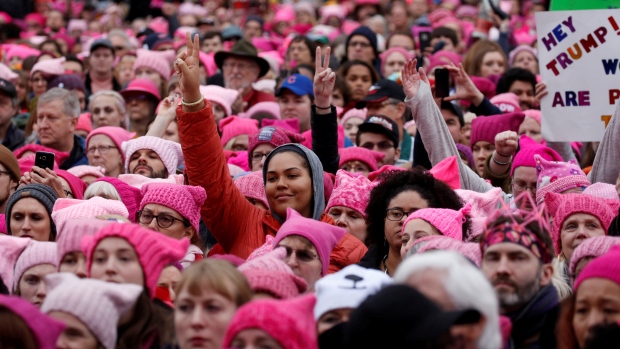“Fashion should always be looked to in protest”
Stood outside Trump Tower, on a street carpeted with placards and protest slogans, Rihanna stands in a LAPP jumper emblazoned with the words “This Pussy Grabs Back” worn underneath a layer of bright pink Molly Goddard tulle. An estimated 3.3 million men and women attended the women’s march on January 21st and fashion played as much of a role in expression as ‘girls just wanna have fun-damental human rights’ being plastered on signs.
Historically, fashion has been used as a tool in protest by acting as a unifying force to create a powerful image. Suffragettes used fashion to escape the image of the dangerously politicised woman who wore masculine clothes, by conforming to early twentieth century feminine fashion and dressing smartly for the cause. Sylvia Pankhurst once said that suffragettes ‘spend more money on clothes than they can comfortably afford, rather than run the risk of being considered outré, and doing harm to the cause’. Another example would be the black berets and leather jackets worn by the Black Panther Party, as decided upon by founders Bobby Seale and Huey P. Newton. The late-noughties ‘slutwalks’ protesting against rape culture also saw fashion unifying protestors many of whom stripped down to their underwear to illustrate that what they wore didn’t mean they were ‘asking for it’.
At this most recent protest, where an estimated half a million people marched on Washington alone, fashion again succeeded in creating a powerful image by means of the ‘Pussyhat Project’ founded by LA based Krista Suh and Jayna Zweiman. Following the release of some sexist comments Trump made back in 2005, the project was born.
The initial aim was to create headwear to keep LA campaigners warm in the Washington climate but the design of a pink hat with cat ears became about reclaiming the term ‘pussy’ and uniformly showing defiance against the man who would somehow hold the presidency. A national campaign was started to knit and sew the hats and send them to marchers. It became inclusive of those unable to march and even spread beyond the US with the pattern being readily available across the world. Founder Krista Suh saw the project as having a ‘dual function’. Speaking to the LA Times she said, “People there could have it to make a unified statement and people at home who couldn’t go could be part of it and represent themselves there.”
Current fashion is certainly fuelling the rebellion. How many times have you recently scrolled past an image of Maria Grazia Chirui for Dior’s ‘we should all be feminists’ slogan tee on Instagram? Vetements can always be looked to for the image of the rebel as can Balenciaga with an increasing sense of realness shown at Demna Gvasalia’s most recent men’s collection in Paris.
Fashion should always be looked to in protest. The clearest form of expression, it can unify a crowd and send a message with clarity. The history of fashion and protest is long and as history begins to repeat itself with a political resurgence of the right, we should utilise our fashion choices. As stated on the Pussyhat project website at the moment, this is a movement not just a moment.
Victoria Copeland

